MAA262 - Activity Based Costing vs. Labour Hour Costing at Wayco
VerifiedAdded on 2023/06/12
|8
|1546
|304
Report
AI Summary
This assignment solution for MAA 262 provides a detailed comparison of activity-based costing (ABC) and labour hour costing methods, particularly in the context of Wayco Leisure Pty Ltd. The report evaluates the product cost and profitability of Wayco Leisure's three product types using both costing methods, highlighting the advantages of ABC in accurately allocating indirect costs and providing a clearer picture of individual product profitability. It addresses concerns raised by the marketing director, managing director, and chairman regarding the implications of each method. Furthermore, the assignment discusses the application of ABC in universities, referencing relevant articles and emphasizing the importance of identifying cost drivers and profitable activities. The analysis concludes that ABC offers superior insights for decision-making compared to the traditional labour hour costing method.
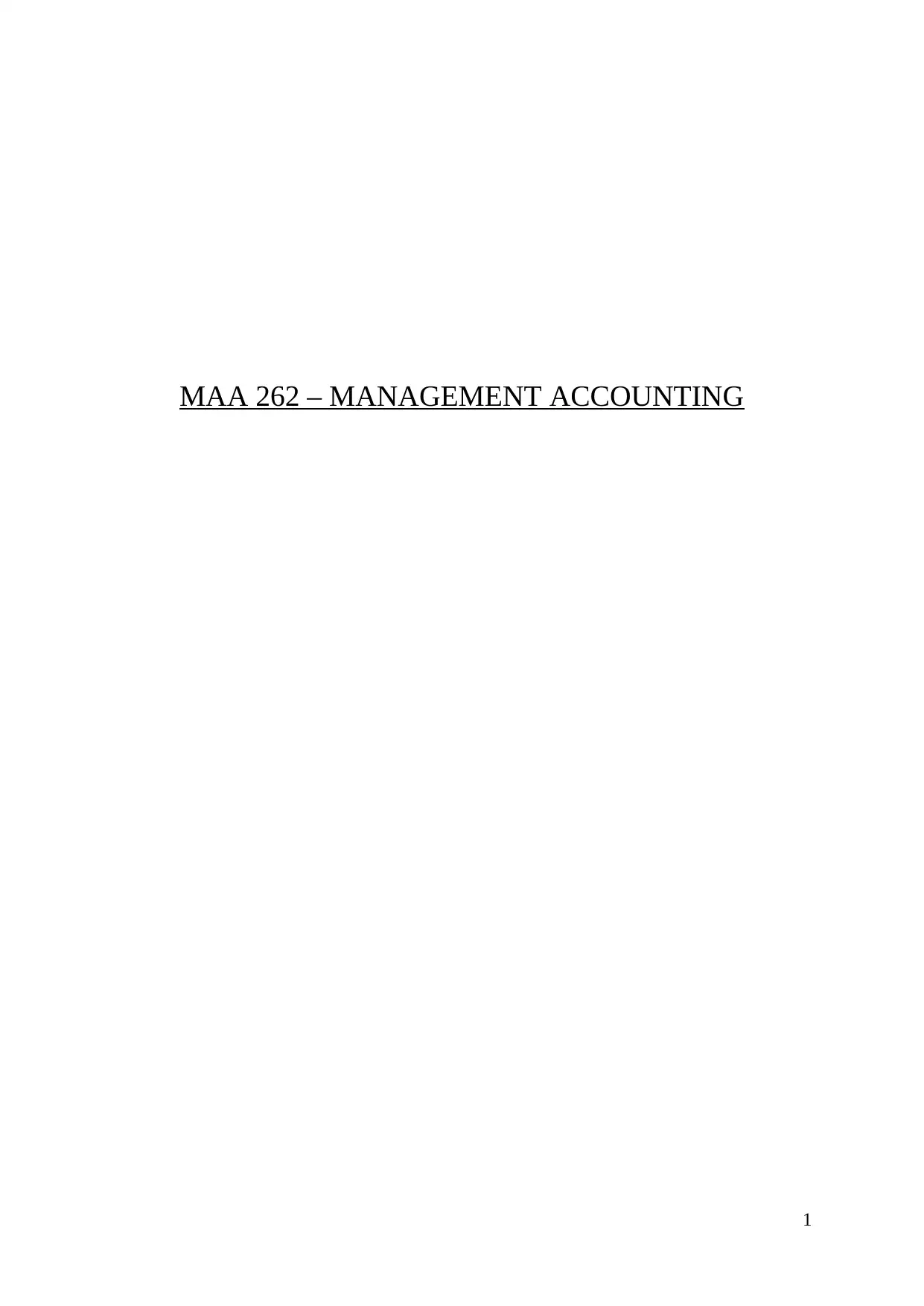
MAA 262 – MANAGEMENT ACCOUNTING
1
1
Paraphrase This Document
Need a fresh take? Get an instant paraphrase of this document with our AI Paraphraser
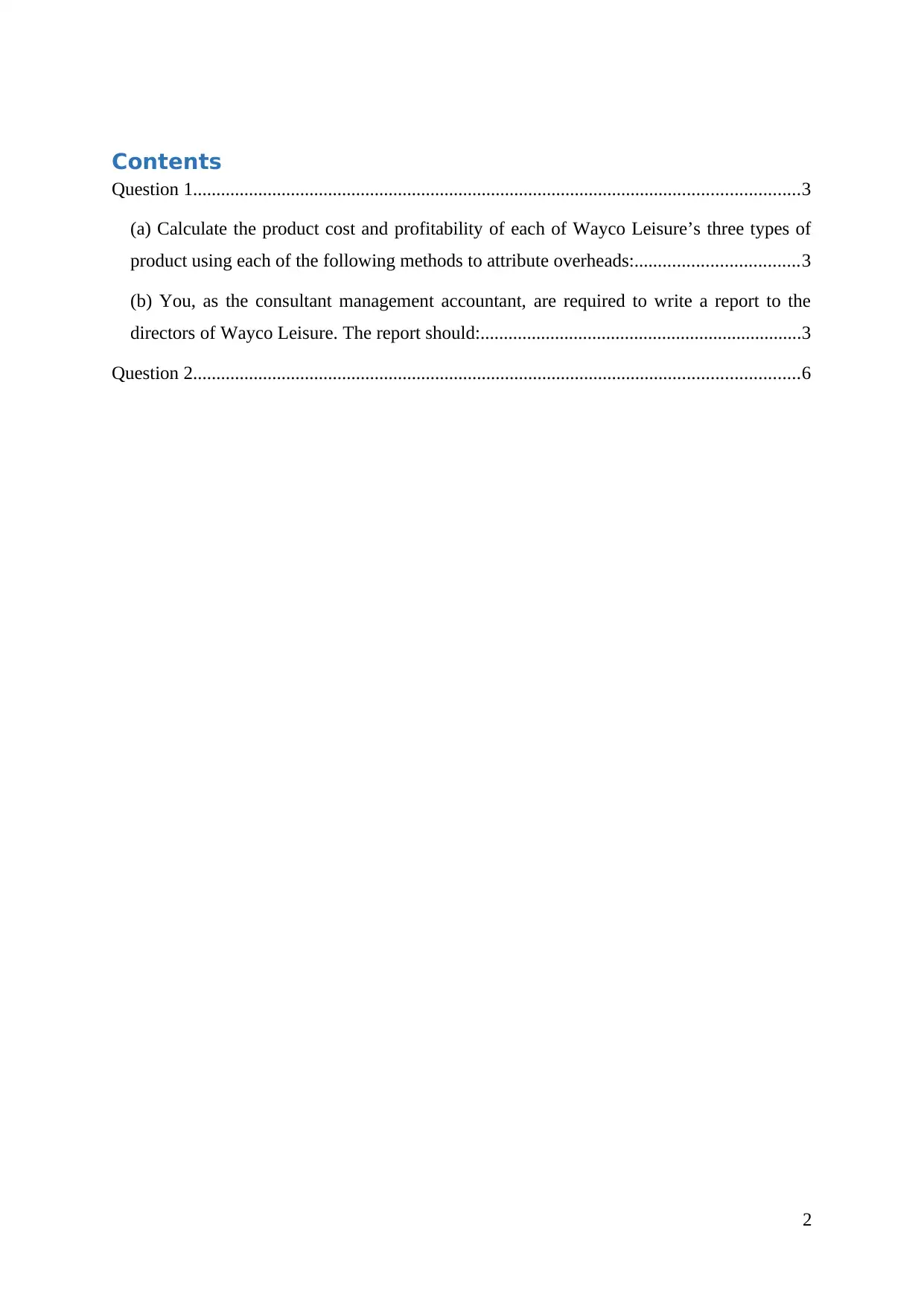
Contents
Question 1..................................................................................................................................3
(a) Calculate the product cost and profitability of each of Wayco Leisure’s three types of
product using each of the following methods to attribute overheads:...................................3
(b) You, as the consultant management accountant, are required to write a report to the
directors of Wayco Leisure. The report should:.....................................................................3
Question 2..................................................................................................................................6
2
Question 1..................................................................................................................................3
(a) Calculate the product cost and profitability of each of Wayco Leisure’s three types of
product using each of the following methods to attribute overheads:...................................3
(b) You, as the consultant management accountant, are required to write a report to the
directors of Wayco Leisure. The report should:.....................................................................3
Question 2..................................................................................................................................6
2
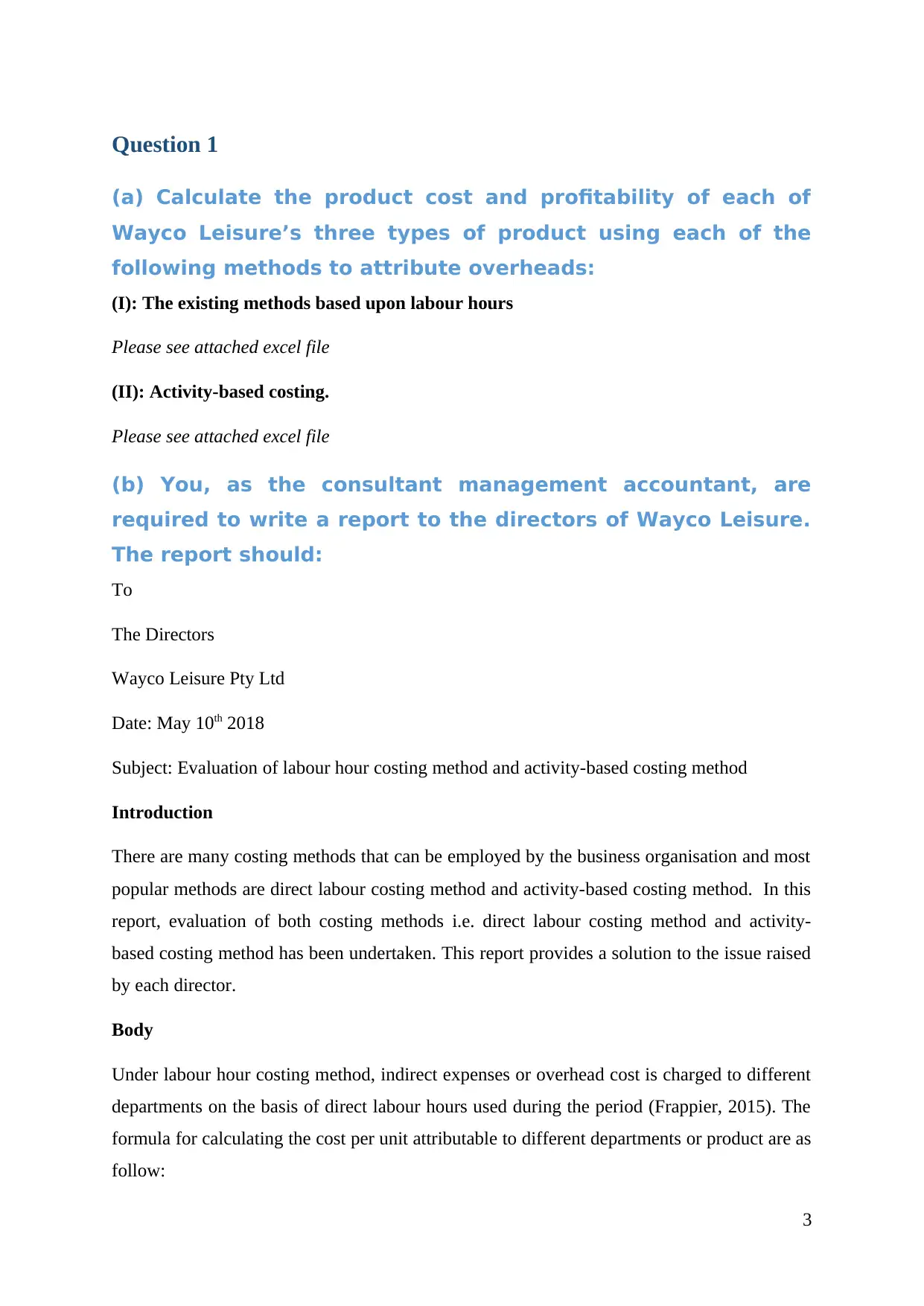
Question 1
(a) Calculate the product cost and profitability of each of
Wayco Leisure’s three types of product using each of the
following methods to attribute overheads:
(I): The existing methods based upon labour hours
Please see attached excel file
(II): Activity-based costing.
Please see attached excel file
(b) You, as the consultant management accountant, are
required to write a report to the directors of Wayco Leisure.
The report should:
To
The Directors
Wayco Leisure Pty Ltd
Date: May 10th 2018
Subject: Evaluation of labour hour costing method and activity-based costing method
Introduction
There are many costing methods that can be employed by the business organisation and most
popular methods are direct labour costing method and activity-based costing method. In this
report, evaluation of both costing methods i.e. direct labour costing method and activity-
based costing method has been undertaken. This report provides a solution to the issue raised
by each director.
Body
Under labour hour costing method, indirect expenses or overhead cost is charged to different
departments on the basis of direct labour hours used during the period (Frappier, 2015). The
formula for calculating the cost per unit attributable to different departments or product are as
follow:
3
(a) Calculate the product cost and profitability of each of
Wayco Leisure’s three types of product using each of the
following methods to attribute overheads:
(I): The existing methods based upon labour hours
Please see attached excel file
(II): Activity-based costing.
Please see attached excel file
(b) You, as the consultant management accountant, are
required to write a report to the directors of Wayco Leisure.
The report should:
To
The Directors
Wayco Leisure Pty Ltd
Date: May 10th 2018
Subject: Evaluation of labour hour costing method and activity-based costing method
Introduction
There are many costing methods that can be employed by the business organisation and most
popular methods are direct labour costing method and activity-based costing method. In this
report, evaluation of both costing methods i.e. direct labour costing method and activity-
based costing method has been undertaken. This report provides a solution to the issue raised
by each director.
Body
Under labour hour costing method, indirect expenses or overhead cost is charged to different
departments on the basis of direct labour hours used during the period (Frappier, 2015). The
formula for calculating the cost per unit attributable to different departments or product are as
follow:
3
⊘ This is a preview!⊘
Do you want full access?
Subscribe today to unlock all pages.

Trusted by 1+ million students worldwide
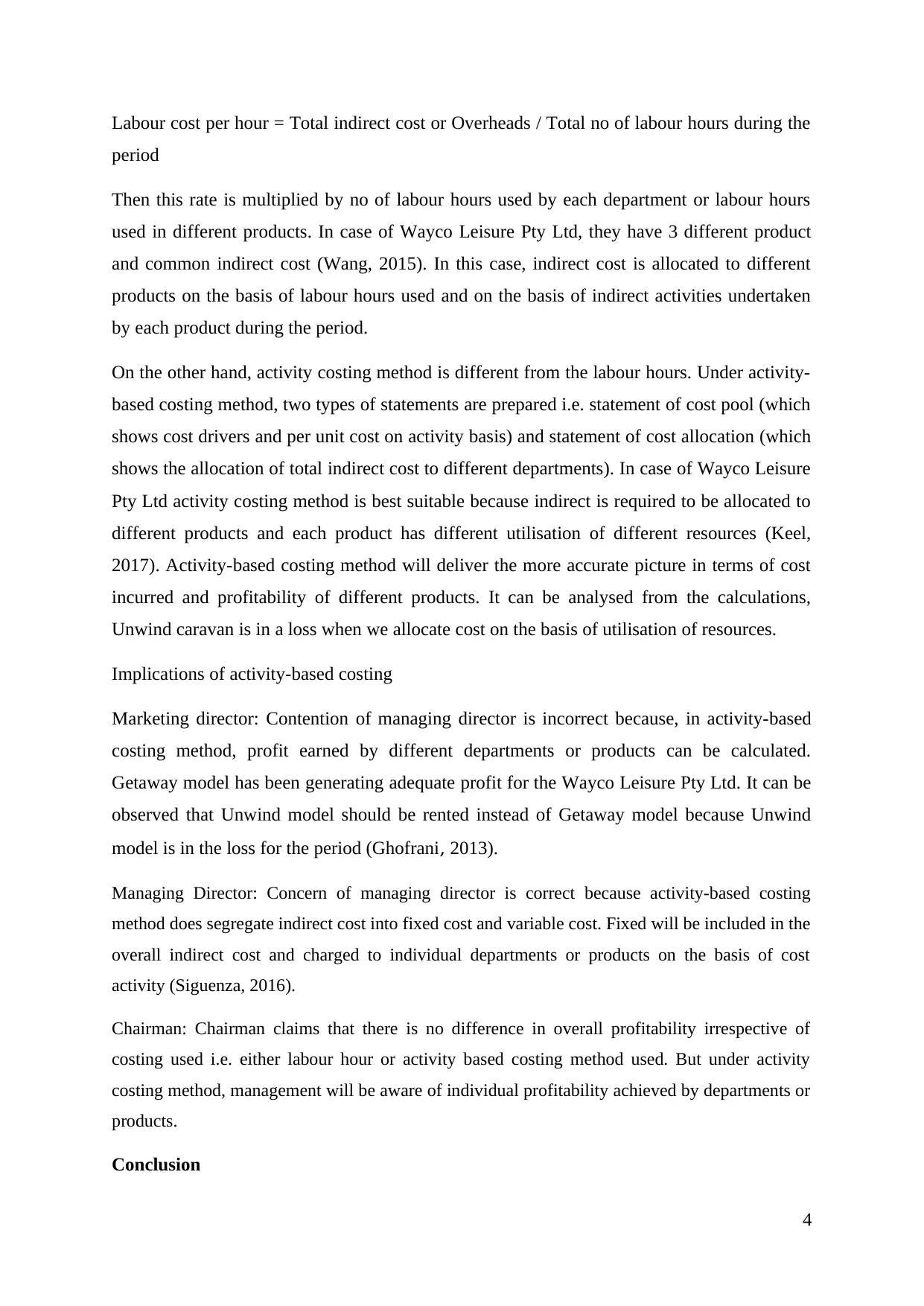
Labour cost per hour = Total indirect cost or Overheads / Total no of labour hours during the
period
Then this rate is multiplied by no of labour hours used by each department or labour hours
used in different products. In case of Wayco Leisure Pty Ltd, they have 3 different product
and common indirect cost (Wang, 2015). In this case, indirect cost is allocated to different
products on the basis of labour hours used and on the basis of indirect activities undertaken
by each product during the period.
On the other hand, activity costing method is different from the labour hours. Under activity-
based costing method, two types of statements are prepared i.e. statement of cost pool (which
shows cost drivers and per unit cost on activity basis) and statement of cost allocation (which
shows the allocation of total indirect cost to different departments). In case of Wayco Leisure
Pty Ltd activity costing method is best suitable because indirect is required to be allocated to
different products and each product has different utilisation of different resources (Keel,
2017). Activity-based costing method will deliver the more accurate picture in terms of cost
incurred and profitability of different products. It can be analysed from the calculations,
Unwind caravan is in a loss when we allocate cost on the basis of utilisation of resources.
Implications of activity-based costing
Marketing director: Contention of managing director is incorrect because, in activity-based
costing method, profit earned by different departments or products can be calculated.
Getaway model has been generating adequate profit for the Wayco Leisure Pty Ltd. It can be
observed that Unwind model should be rented instead of Getaway model because Unwind
model is in the loss for the period (Ghofrani, 2013).
Managing Director: Concern of managing director is correct because activity-based costing
method does segregate indirect cost into fixed cost and variable cost. Fixed will be included in the
overall indirect cost and charged to individual departments or products on the basis of cost
activity (Siguenza, 2016).
Chairman: Chairman claims that there is no difference in overall profitability irrespective of
costing used i.e. either labour hour or activity based costing method used. But under activity
costing method, management will be aware of individual profitability achieved by departments or
products.
Conclusion
4
period
Then this rate is multiplied by no of labour hours used by each department or labour hours
used in different products. In case of Wayco Leisure Pty Ltd, they have 3 different product
and common indirect cost (Wang, 2015). In this case, indirect cost is allocated to different
products on the basis of labour hours used and on the basis of indirect activities undertaken
by each product during the period.
On the other hand, activity costing method is different from the labour hours. Under activity-
based costing method, two types of statements are prepared i.e. statement of cost pool (which
shows cost drivers and per unit cost on activity basis) and statement of cost allocation (which
shows the allocation of total indirect cost to different departments). In case of Wayco Leisure
Pty Ltd activity costing method is best suitable because indirect is required to be allocated to
different products and each product has different utilisation of different resources (Keel,
2017). Activity-based costing method will deliver the more accurate picture in terms of cost
incurred and profitability of different products. It can be analysed from the calculations,
Unwind caravan is in a loss when we allocate cost on the basis of utilisation of resources.
Implications of activity-based costing
Marketing director: Contention of managing director is incorrect because, in activity-based
costing method, profit earned by different departments or products can be calculated.
Getaway model has been generating adequate profit for the Wayco Leisure Pty Ltd. It can be
observed that Unwind model should be rented instead of Getaway model because Unwind
model is in the loss for the period (Ghofrani, 2013).
Managing Director: Concern of managing director is correct because activity-based costing
method does segregate indirect cost into fixed cost and variable cost. Fixed will be included in the
overall indirect cost and charged to individual departments or products on the basis of cost
activity (Siguenza, 2016).
Chairman: Chairman claims that there is no difference in overall profitability irrespective of
costing used i.e. either labour hour or activity based costing method used. But under activity
costing method, management will be aware of individual profitability achieved by departments or
products.
Conclusion
4
Paraphrase This Document
Need a fresh take? Get an instant paraphrase of this document with our AI Paraphraser
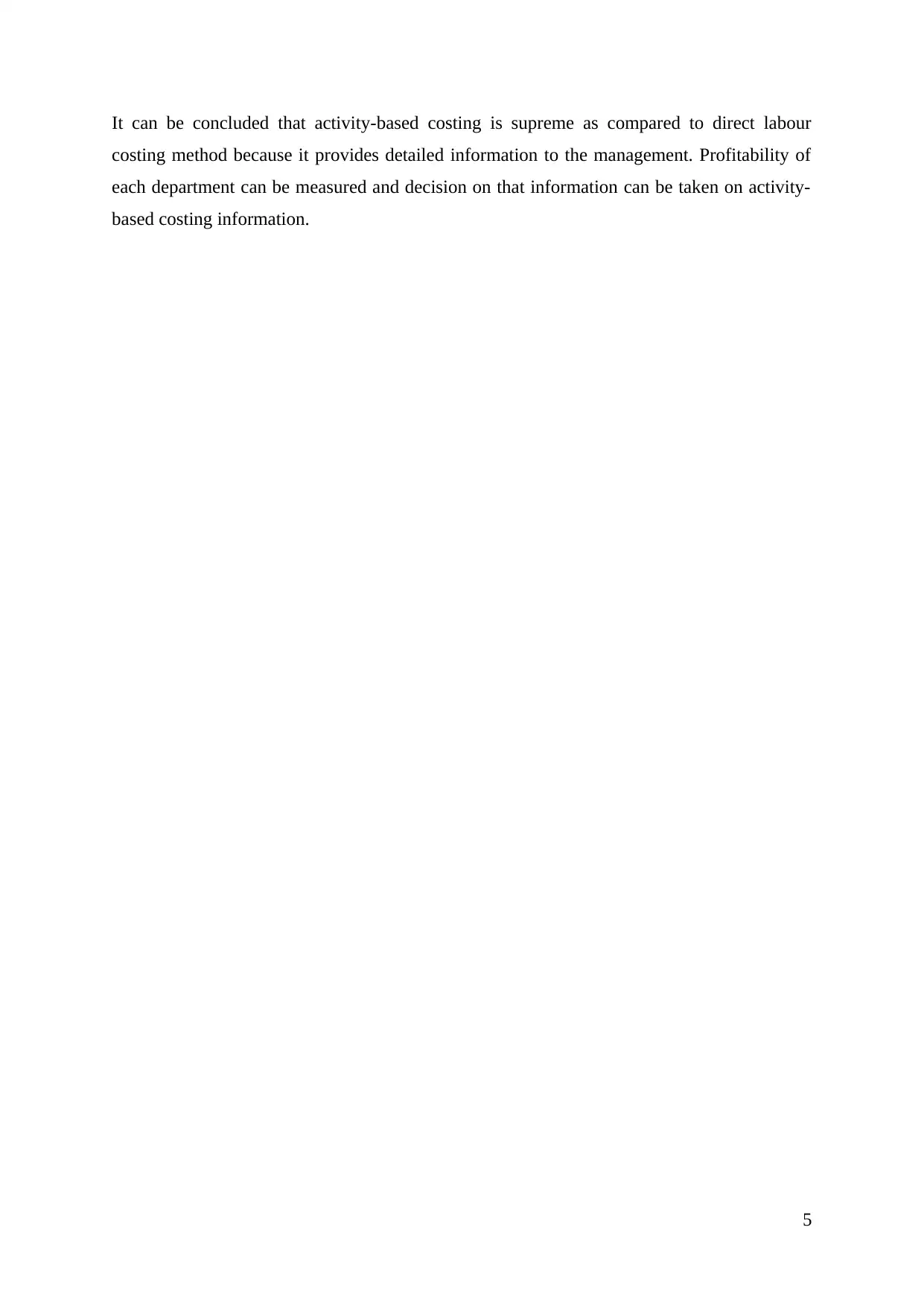
It can be concluded that activity-based costing is supreme as compared to direct labour
costing method because it provides detailed information to the management. Profitability of
each department can be measured and decision on that information can be taken on activity-
based costing information.
5
costing method because it provides detailed information to the management. Profitability of
each department can be measured and decision on that information can be taken on activity-
based costing information.
5
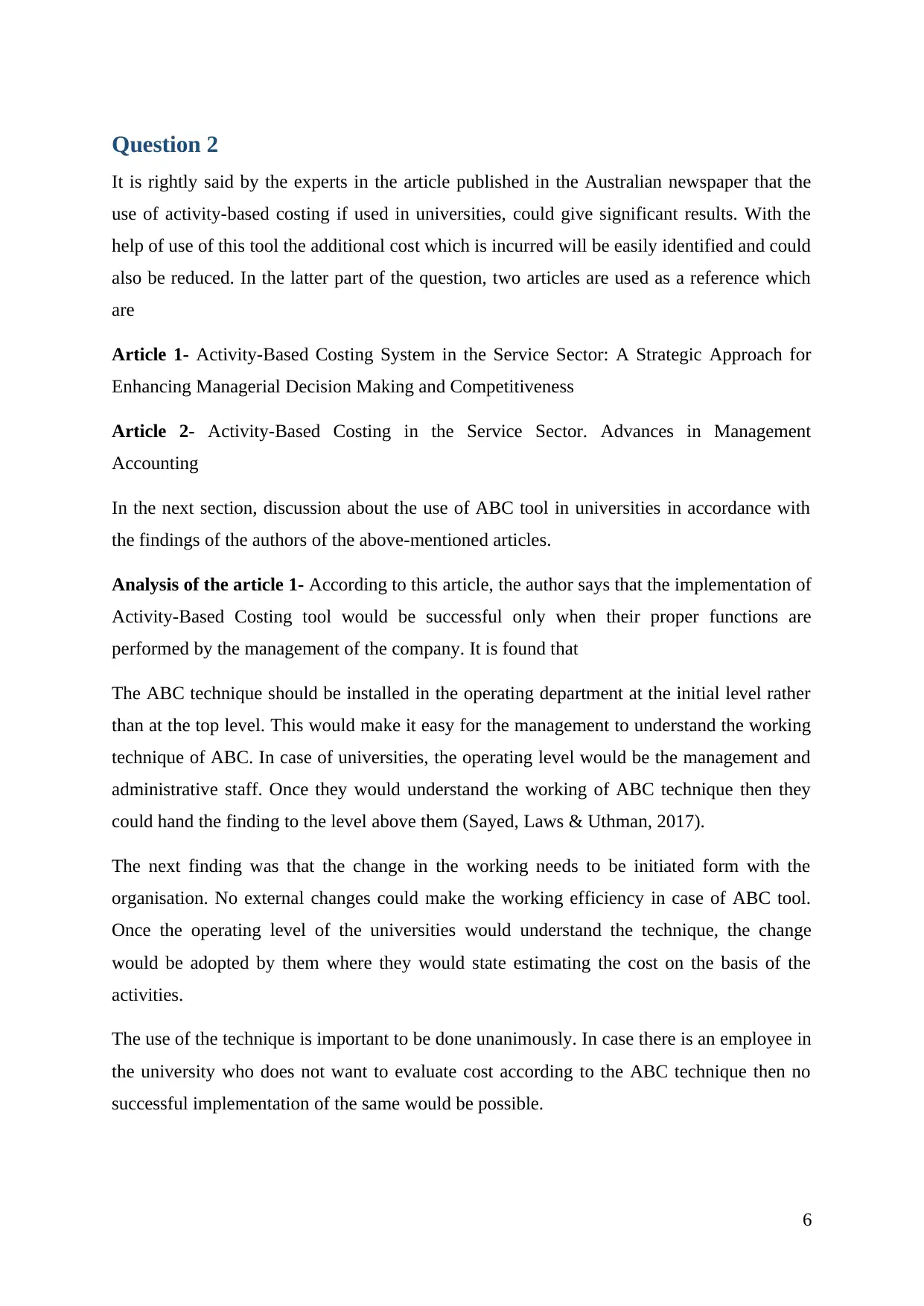
Question 2
It is rightly said by the experts in the article published in the Australian newspaper that the
use of activity-based costing if used in universities, could give significant results. With the
help of use of this tool the additional cost which is incurred will be easily identified and could
also be reduced. In the latter part of the question, two articles are used as a reference which
are
Article 1- Activity-Based Costing System in the Service Sector: A Strategic Approach for
Enhancing Managerial Decision Making and Competitiveness
Article 2- Activity-Based Costing in the Service Sector. Advances in Management
Accounting
In the next section, discussion about the use of ABC tool in universities in accordance with
the findings of the authors of the above-mentioned articles.
Analysis of the article 1- According to this article, the author says that the implementation of
Activity-Based Costing tool would be successful only when their proper functions are
performed by the management of the company. It is found that
The ABC technique should be installed in the operating department at the initial level rather
than at the top level. This would make it easy for the management to understand the working
technique of ABC. In case of universities, the operating level would be the management and
administrative staff. Once they would understand the working of ABC technique then they
could hand the finding to the level above them (Sayed, Laws & Uthman, 2017).
The next finding was that the change in the working needs to be initiated form with the
organisation. No external changes could make the working efficiency in case of ABC tool.
Once the operating level of the universities would understand the technique, the change
would be adopted by them where they would state estimating the cost on the basis of the
activities.
The use of the technique is important to be done unanimously. In case there is an employee in
the university who does not want to evaluate cost according to the ABC technique then no
successful implementation of the same would be possible.
6
It is rightly said by the experts in the article published in the Australian newspaper that the
use of activity-based costing if used in universities, could give significant results. With the
help of use of this tool the additional cost which is incurred will be easily identified and could
also be reduced. In the latter part of the question, two articles are used as a reference which
are
Article 1- Activity-Based Costing System in the Service Sector: A Strategic Approach for
Enhancing Managerial Decision Making and Competitiveness
Article 2- Activity-Based Costing in the Service Sector. Advances in Management
Accounting
In the next section, discussion about the use of ABC tool in universities in accordance with
the findings of the authors of the above-mentioned articles.
Analysis of the article 1- According to this article, the author says that the implementation of
Activity-Based Costing tool would be successful only when their proper functions are
performed by the management of the company. It is found that
The ABC technique should be installed in the operating department at the initial level rather
than at the top level. This would make it easy for the management to understand the working
technique of ABC. In case of universities, the operating level would be the management and
administrative staff. Once they would understand the working of ABC technique then they
could hand the finding to the level above them (Sayed, Laws & Uthman, 2017).
The next finding was that the change in the working needs to be initiated form with the
organisation. No external changes could make the working efficiency in case of ABC tool.
Once the operating level of the universities would understand the technique, the change
would be adopted by them where they would state estimating the cost on the basis of the
activities.
The use of the technique is important to be done unanimously. In case there is an employee in
the university who does not want to evaluate cost according to the ABC technique then no
successful implementation of the same would be possible.
6
⊘ This is a preview!⊘
Do you want full access?
Subscribe today to unlock all pages.

Trusted by 1+ million students worldwide

It is important to identify the cost drivers. There is such part of the activity that attracts the
cost and increases it as a whole. In case of work dine in universities the cost drivers could be
an event, trips, payment made to externals, etc.
Analysis of the article 2- In this article the following finding were analyses for the working
in universities
The identification of the activities which are profitable for the universities should be
promoted. A trend of the profitability with regard to the activities should be found. in case of
universities, the activities which could lead to maximising profits would be- admissions of
new students, examination fees, event based on own fund bases, etc.
Cost Pool- Accumulation of indirect cost of each department into a group is cost pool. It is
used as a base for ABC costing for allocating indirect cost according to the department’s
activities. Example- The library cost at universities could be a good example of cost pool.
The indirect cost associated is library operations, utility cost, depreciation on building and
equipment, maintenance cost, etc. Accumulation of this cost would group them into a cost
pool.
7
cost and increases it as a whole. In case of work dine in universities the cost drivers could be
an event, trips, payment made to externals, etc.
Analysis of the article 2- In this article the following finding were analyses for the working
in universities
The identification of the activities which are profitable for the universities should be
promoted. A trend of the profitability with regard to the activities should be found. in case of
universities, the activities which could lead to maximising profits would be- admissions of
new students, examination fees, event based on own fund bases, etc.
Cost Pool- Accumulation of indirect cost of each department into a group is cost pool. It is
used as a base for ABC costing for allocating indirect cost according to the department’s
activities. Example- The library cost at universities could be a good example of cost pool.
The indirect cost associated is library operations, utility cost, depreciation on building and
equipment, maintenance cost, etc. Accumulation of this cost would group them into a cost
pool.
7
Paraphrase This Document
Need a fresh take? Get an instant paraphrase of this document with our AI Paraphraser
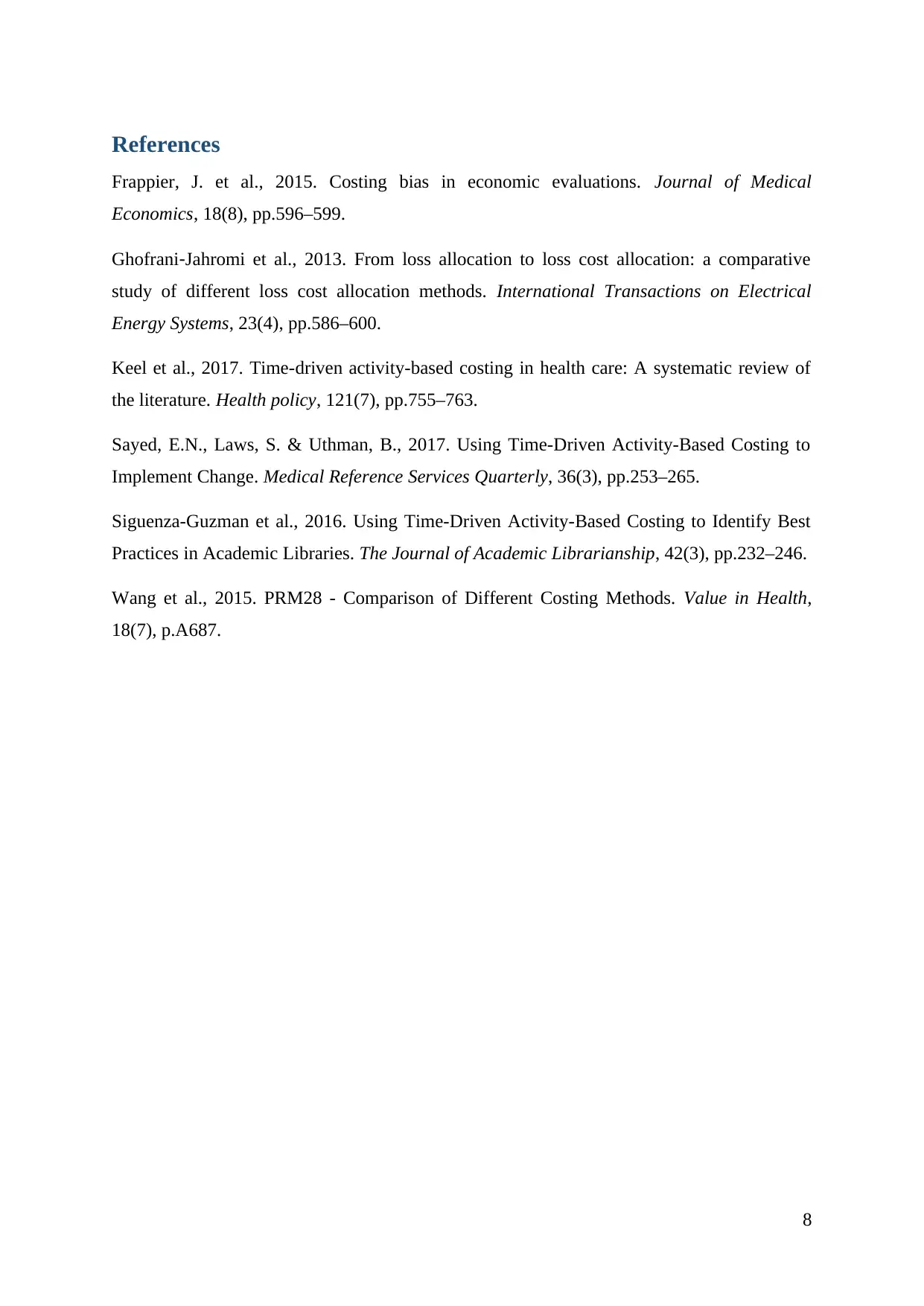
References
Frappier, J. et al., 2015. Costing bias in economic evaluations. Journal of Medical
Economics, 18(8), pp.596–599.
Ghofrani‐Jahromi et al., 2013. From loss allocation to loss cost allocation: a comparative
study of different loss cost allocation methods. International Transactions on Electrical
Energy Systems, 23(4), pp.586–600.
Keel et al., 2017. Time-driven activity-based costing in health care: A systematic review of
the literature. Health policy, 121(7), pp.755–763.
Sayed, E.N., Laws, S. & Uthman, B., 2017. Using Time-Driven Activity-Based Costing to
Implement Change. Medical Reference Services Quarterly, 36(3), pp.253–265.
Siguenza-Guzman et al., 2016. Using Time-Driven Activity-Based Costing to Identify Best
Practices in Academic Libraries. The Journal of Academic Librarianship, 42(3), pp.232–246.
Wang et al., 2015. PRM28 - Comparison of Different Costing Methods. Value in Health,
18(7), p.A687.
8
Frappier, J. et al., 2015. Costing bias in economic evaluations. Journal of Medical
Economics, 18(8), pp.596–599.
Ghofrani‐Jahromi et al., 2013. From loss allocation to loss cost allocation: a comparative
study of different loss cost allocation methods. International Transactions on Electrical
Energy Systems, 23(4), pp.586–600.
Keel et al., 2017. Time-driven activity-based costing in health care: A systematic review of
the literature. Health policy, 121(7), pp.755–763.
Sayed, E.N., Laws, S. & Uthman, B., 2017. Using Time-Driven Activity-Based Costing to
Implement Change. Medical Reference Services Quarterly, 36(3), pp.253–265.
Siguenza-Guzman et al., 2016. Using Time-Driven Activity-Based Costing to Identify Best
Practices in Academic Libraries. The Journal of Academic Librarianship, 42(3), pp.232–246.
Wang et al., 2015. PRM28 - Comparison of Different Costing Methods. Value in Health,
18(7), p.A687.
8
1 out of 8
Related Documents
Your All-in-One AI-Powered Toolkit for Academic Success.
+13062052269
info@desklib.com
Available 24*7 on WhatsApp / Email
![[object Object]](/_next/static/media/star-bottom.7253800d.svg)
Unlock your academic potential
Copyright © 2020–2025 A2Z Services. All Rights Reserved. Developed and managed by ZUCOL.





